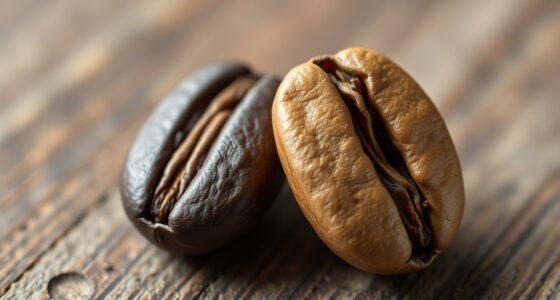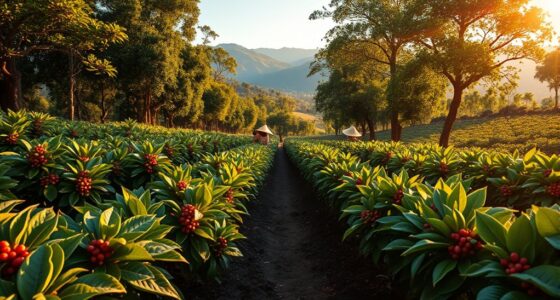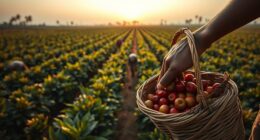Shade-grown farming impacts in-cup sweetness by creating a cooler microclimate that slows ripening and allows beans to develop richer sugars and complex flavor compounds. The shade trees help regulate temperature and humidity, reducing stress and encouraging a more balanced chemical profile. This gradual ripening process results in a smoother, more nuanced sweetness in your coffee. Want to discover how these natural conditions boost flavor depth even further? Keep exploring below.
Key Takeaways
- Shade slows ripening, allowing for gradual sugar accumulation and enhanced in-cup sweetness.
- Canopy coverage filters sunlight, reducing stress and promoting balanced sugar and acid development.
- Cooler microclimates under shade support enzyme activity essential for complex flavor and sweetness.
- Extended ripening periods in shade-grown coffee lead to more uniform and higher sugar content.
- Shade trees promote healthier plants and pest control, indirectly contributing to better bean quality and sweetness.
The Role of Shade Trees in Coffee Cultivation
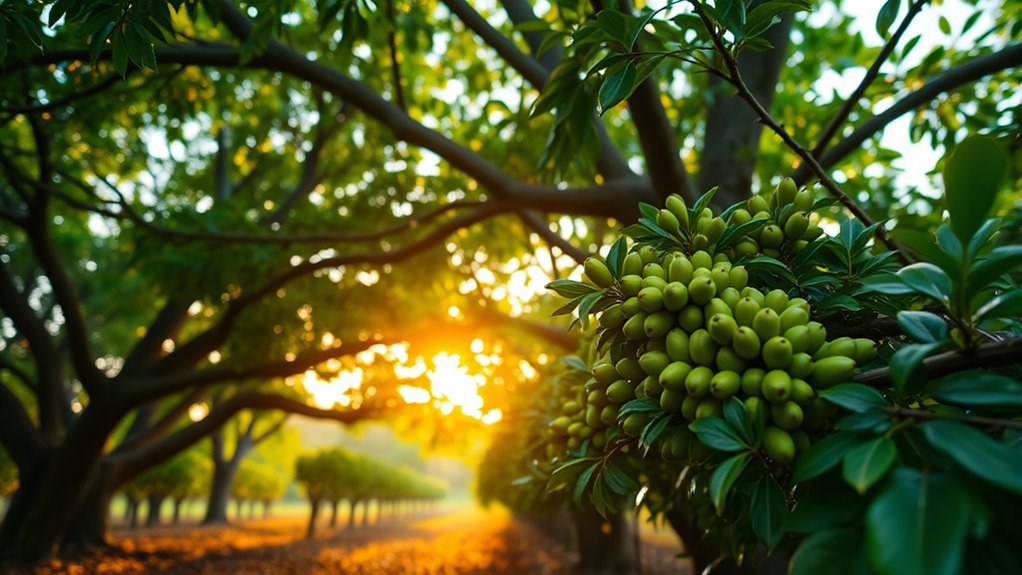
Shade trees play a crucial role in coffee cultivation by providing a natural canopy that protects coffee plants from harsh sunlight and extreme weather conditions. This canopy creates a cooler microclimate, reducing stress on the plants and helping prevent pest outbreaks, which often thrive in hotter, drier conditions. By fostering a diverse ecosystem, shade trees enhance biodiversity, attracting beneficial insects and birds that naturally control pests, decreasing reliance on chemical interventions. This balance not only promotes healthier coffee plants but also supports overall farm resilience. The presence of shade trees encourages a thriving, interconnected environment, which benefits the entire coffee ecosystem. Additionally, the use of proper pruning techniques ensures that shade trees continue to provide optimal benefits without competing excessively with coffee plants. As a result, shade-grown coffee farms often see better pest control and a richer biodiversity, contributing to higher quality coffee beans.
How Shade Influences Coffee Ripening and Maturity

When coffee plants grow under a canopy of shade, the ripening process slows down, allowing the beans to develop more evenly and fully. This gradual maturation improves flavor complexity and enhances in-cup sweetness. Shade also promotes biodiversity enhancement, creating habitats that support beneficial insects and birds, which naturally control pests. Additionally, shade trees aid in carbon sequestration, reducing overall greenhouse gases. As a result, ripening becomes more consistent, and maturity is reached at a steady pace, guaranteeing ideal bean quality. This balanced development leads to better flavor profiles and sustainable farming practices, reinforcing the benefits of shade-grown coffee. Furthermore, implementing tuning techniques similar to those used in automotive modifications can optimize growth conditions, ensuring the plants reach their full potential.
The Impact of Shade on Coffee Bean Composition

The way shade influences the chemical makeup of coffee beans plays a significant role in shaping their flavor profile and overall quality. Shade coffee tends to develop a different bean composition compared to sun-grown varieties. The cooler, more stable environment under shade promotes balanced accumulation of sugars, acids, and other compounds. This results in beans with higher sugar content and complex organic acids, which directly impact in-cup sweetness and flavor depth. Additionally, shade can reduce stress on the plants, leading to slower maturation and allowing beans to develop richer chemical profiles. As a result, shade-grown coffee often exhibits a more nuanced bean composition, with enhanced aroma and taste qualities. Furthermore, shade can support sustainable farming practices that benefit both the environment and crop quality. This altered chemical makeup is key to the distinctive, desirable characteristics associated with shade-grown coffee.
Shade’s Effect on Enzymatic Activity and Flavor Development
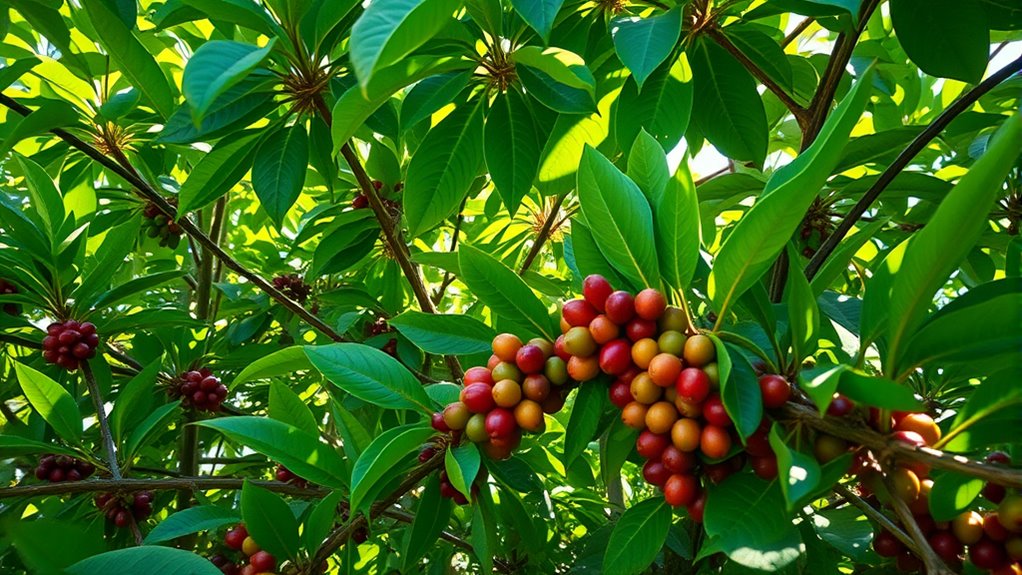
Enzymatic activity in coffee beans is a crucial factor influencing the development of their complex flavors, and shade conditions considerably affect this process. Shade reduces direct sunlight, which can lower photosynthesis efficiency, leading to a more gradual maturation of the beans. This slower growth allows enzymes involved in ripening and flavor development to function ideally. As enzyme activity becomes more balanced, it promotes the formation of desirable flavor compounds, enhancing sweetness and depth. In contrast, full sun exposure may accelerate enzyme reactions unevenly, potentially compromising flavor complexity. By maintaining a moderated environment, shade helps regulate enzymatic activity, ensuring the beans develop nuanced flavors that contribute to a richer, sweeter in-cup profile. Additionally, understanding the impact of environmental factors on enzymatic processes can further optimize flavor outcomes.
Microclimate Benefits of Shade-Grown Coffee
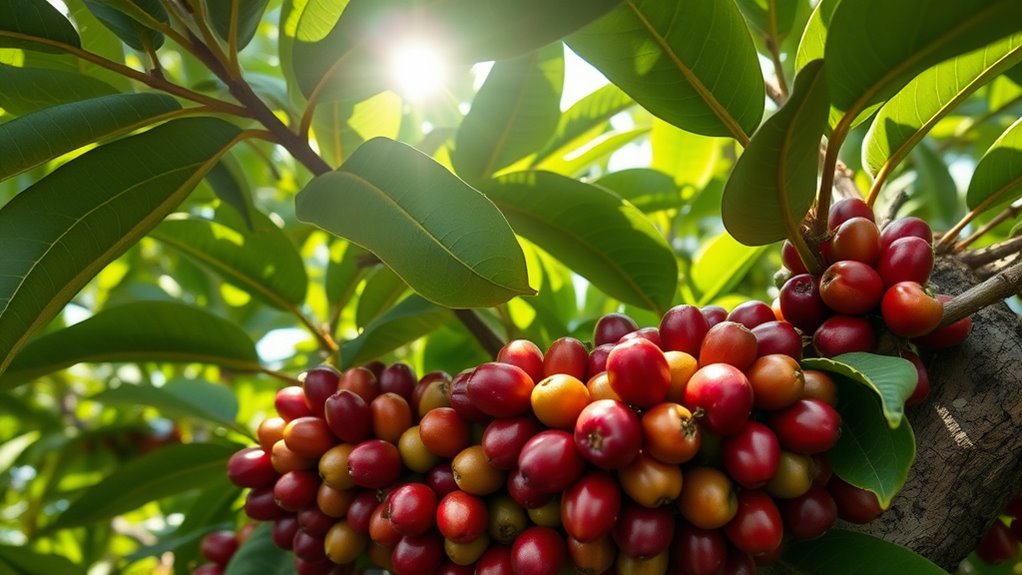
When you grow coffee under shade, it helps keep temperatures more stable, preventing extreme heat that can stress plants. This creates a comfortable environment for coffee to develop its natural sweetness. Additionally, the shade maintains higher humidity levels, fostering a healthy microclimate that benefits the crop.
Temperature Regulation Benefits
Shade-grown coffee benefits from a natural microclimate that helps regulate temperature, protecting plants from extreme heat and cold. Canopy density plays a key role in this process; a well-managed shade canopy filters sunlight and moderates temperature fluctuations. Proper shade management ensures the coffee plants stay cooler during hot days and insulated during cooler nights, reducing stress and promoting steady growth. By maintaining ideal canopy density, you prevent overheating that could impair bean development and preserve essential temperature conditions. This natural temperature regulation fosters a stable environment, allowing the coffee plants to thrive without the need for artificial cooling systems. Additionally, dog names can be used to symbolize personality traits that suit different breeds, which can be useful when selecting the perfect name for your coffee plants’ own unique characteristics. Ultimately, these microclimate benefits help produce better in-cup sweetness by supporting consistent ripening and flavor development.
Humidity and Microclimates
Shade trees create a microclimate that maintains higher humidity levels around coffee plants, which is essential for their health and flavor development. This elevated humidity helps keep soil moisture consistent, reducing stress on the plants and encouraging ideal bean maturation. The dense leaf canopy acts as a barrier, reducing wind and evaporation, which preserves soil moisture and stabilizes the environment. Benefits include:
- Enhanced leaf canopy coverage, trapping moisture
- Reduced soil moisture loss through evaporation
- Stabilized microclimate, preventing rapid temperature swings
- Improved plant resilience to drought stress
- Better conditions for slow, in-depth flavor development
- Vertical storage solutions maximize space and help organize the microclimate environment more efficiently
This microclimate naturally fosters a stable environment, empowering coffee plants to produce sweeter, more complex beans.
Comparing Shade-Grown and Sun-Exposed Coffee in Terms of Sweetness
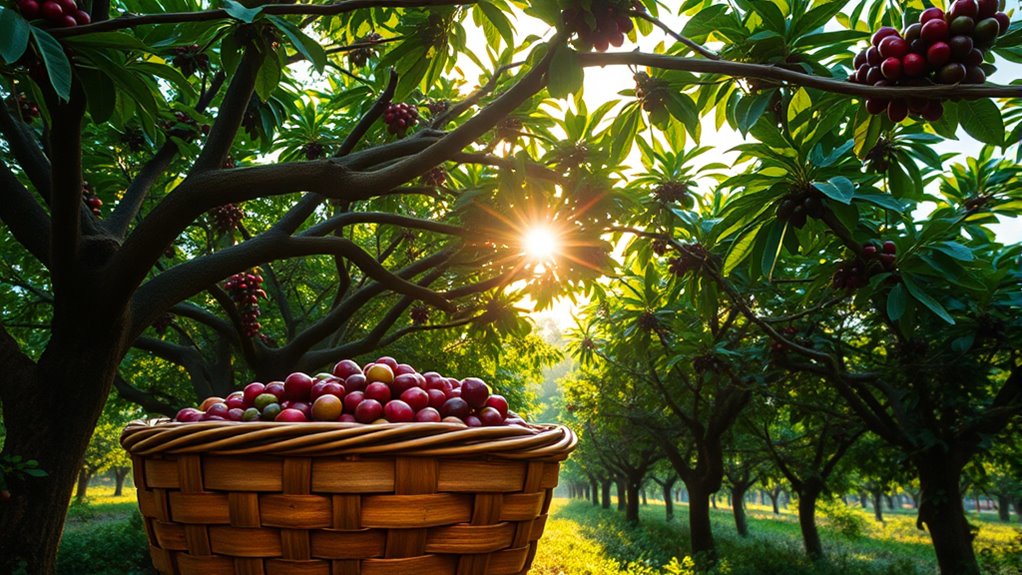
You’ll notice that shade-grown coffee often develops more complex sugars, making it generally sweeter than sun-exposed varieties. The ripening process takes longer under shade, which allows beans to mature fully and enhance flavor. As a result, shade-grown beans tend to have higher quality and richer sweetness compared to those grown in direct sunlight. Additionally, wall organization systems can be used to keep your coffee area neat, making it easier to appreciate the aesthetic qualities of your brew.
Sugar Development Differences
The way coffee cherries develop their sugars varies markedly depending on whether they grow under canopy shade or in full sun. In shaded environments, slower maturation allows sugars to accumulate more evenly, resulting in sweeter beans. Sun-exposed coffee often ripens quickly, which can limit sugar development. Factors influencing sugar levels include:
- Increased pest control challenges in shade, affecting fruit health
- Enhanced soil fertility under shade trees, promoting better sugar synthesis
- Cooler temperatures in shaded areas slow down metabolism, aiding sugar buildup
- Reduced stress from extreme sunlight helps cherries focus on ripening
- Consistent moisture levels in shade improve sugar development
Ripening Time Variations
Ripening time plays a crucial role in determining the sweetness of coffee beans, with noticeable differences between shade-grown and sun-exposed crops. Shade-grown coffee typically ripens more slowly, allowing beans to develop complex sugars and richer flavors. Higher altitudes, often associated with shade-grown farms, enhance this process by reducing temperatures, which extend ripening periods. This longer ripening cycle promotes more uniform sugar accumulation, boosting sweetness. Additionally, shade trees improve pest resistance, reducing the need for chemical interventions that can disrupt ripening. In contrast, sun-exposed coffee tends to ripen faster due to higher temperatures, sometimes resulting in less developed sugars and diminished sweetness. Understanding these ripening time variations helps you appreciate how shade-grown practices enhance coffee’s in-cup sweetness through natural, altitude-related effects, and how ripening cycles influence flavor development.
Coffee Bean Quality
Shade-grown coffee beans generally develop higher levels of natural sugars compared to sun-exposed beans, resulting in a sweeter flavor profile. This enhanced sweetness is linked to better soil health, which supports nutrient uptake and bean development. Shade trees help manage pests naturally, reducing the need for chemical interventions that can harm bean quality. The result is beans with richer aroma, improved acidity, and balanced sweetness.
Key factors influencing coffee bean quality include:
- Soil health, which enhances nutrient availability
- Pest management, reducing stress on plants
- Longer ripening periods, allowing sugars to accumulate
- Reduced exposure to harsh sunlight, preventing bean damage
- Overall plant health, leading to consistent, high-quality beans
Sustainable Practices and Their Long-Term Effects on Flavor
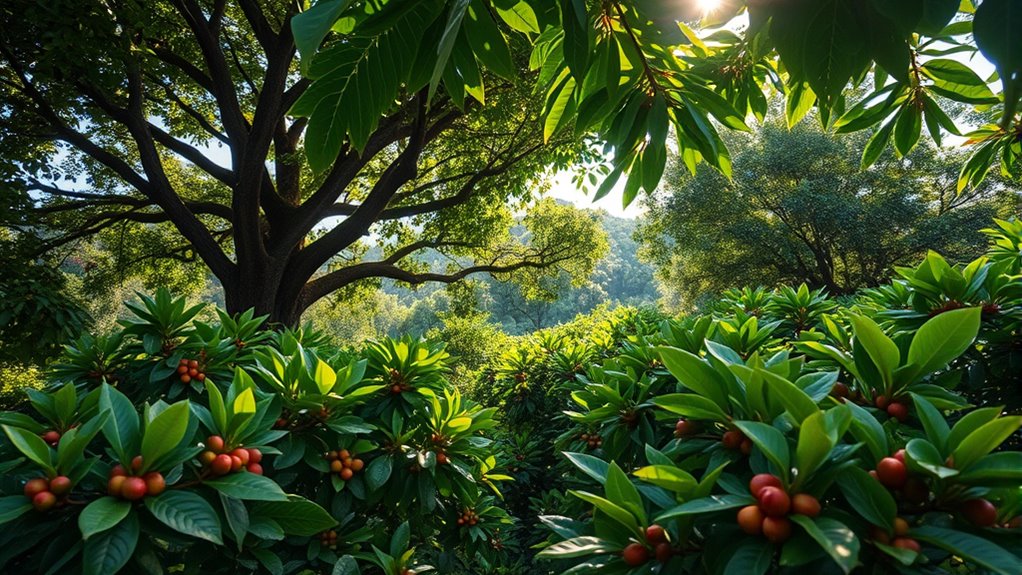
Implementing sustainable farming practices, such as maintaining diverse shade canopies and minimizing chemical use, can substantially influence coffee flavor over time. These methods support the preservation of cultural heritage by respecting traditional techniques and promote economic resilience through healthier soils and better yields. Sustainable practices foster a balanced ecosystem, which enhances the coffee’s complexity and sweetness.
| Practice | Impact on Flavor | Cultural/Economic Benefits |
|---|---|---|
| Diverse shade canopies | Improves in-cup sweetness | Preserves traditional farming methods |
| Reduced chemical use | Enhances natural flavor profiles | Strengthens local economies |
| Organic fertilization | Promotes long-term soil health | Ensures sustainable livelihoods |
Consumer Perception and the Sensory Profile of Shade-Grown Coffee
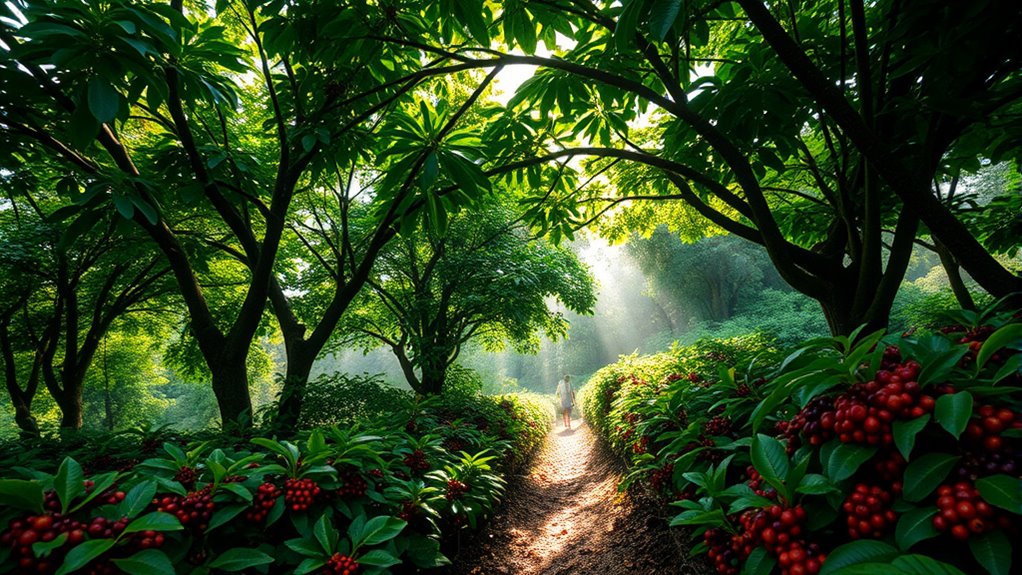
Consumers are increasingly recognizing the unique qualities of shade-grown coffee, influencing their perceptions and preferences. This shift affects consumer expectations and how they perceive flavor profiles. Shade-grown coffee often features a complex, balanced taste with nuanced sweetness, which appeals to discerning palates. Your understanding of these sensory cues shapes your overall experience. Additionally, awareness of narcissistic traits in marketing or branding can influence perceptions of authenticity and quality in specialty coffees.
Frequently Asked Questions
Does Shade-Grown Coffee Require Different Harvesting Techniques?
You’ll find that shade-grown coffee often needs different harvesting techniques compared to sun-grown varieties. Because the cherries ripen unevenly under the canopy, you might need to selectively pick ripe cherries instead of a bulk harvest. This can increase labor requirements, as it’s more time-consuming and labor-intensive. However, this careful approach often results in higher-quality beans, preserving the nuanced flavors and sweetness that shade-grown coffee is known for.
How Does Altitude Interact With Shade to Affect Sweetness?
Did you know that high-altitude farms can produce coffee with up to 50% more sweetness? Altitude effects and shade synergy work together to boost flavor complexity. When grown at higher elevations under shade, coffee cherries mature more slowly, allowing sugars to develop fully. This interaction enhances sweetness and balances acidity, giving you a richer, more nuanced cup. So, the combination of altitude and shade truly elevates your coffee experience.
Are There Specific Coffee Varieties Best Suited for Shade Cultivation?
You’ll find that certain coffee varieties, like Typica and Bourbon, thrive in shade-grown environments due to their genetics. These varieties often benefit from shade’s biodiversity, which helps protect them from pests and improves overall health. Shade-grown farming can enhance flavor complexity, but choosing the right coffee plant genetics guarantees ideal growth and quality. So, focus on varieties well-suited for shade to maximize both sustainability and cup sweetness.
What Are the Economic Implications of Shifting to Shade-Grown Practices?
Shifting to shade-grown farming can boost your business’s economic sustainability by opening doors to demand-driven markets that value environmentally friendly practices. You’ll face financial fluctuations, but benefits include better crop resilience and long-term profitability. Market demand for sustainable, shade-grown coffee continues climbing, encouraging consumers to support eco-conscious choices. While initial investments might seem steep, the payoff promises a more prosperous, sustainable future, blending ecological health with economic growth.
How Does Shade Impact the Resilience of Coffee Plants to Pests?
Shade helps your coffee plants resist pests by boosting their overall plant health and creating a natural barrier. When you grow under shade, the microclimate remains cooler and more stable, making it harder for pests to thrive. This environment encourages pest resistance, reduces the need for chemical interventions, and strengthens your plants’ resilience, ensuring healthier crops and more sustainable farming practices.
Conclusion
By choosing shade-grown coffee, you’re planting seeds for a richer, sweeter cup that’s nurtured by nature’s gentle hand. The shade acts like a caring guardian, guiding the beans to ripen perfectly and develop their vibrant flavors. When you savor that cup, you taste the harmony of a microclimate built on sustainability and patience. It’s more than coffee—it’s a symphony brewed from the quiet wisdom of shade-grown farms.


